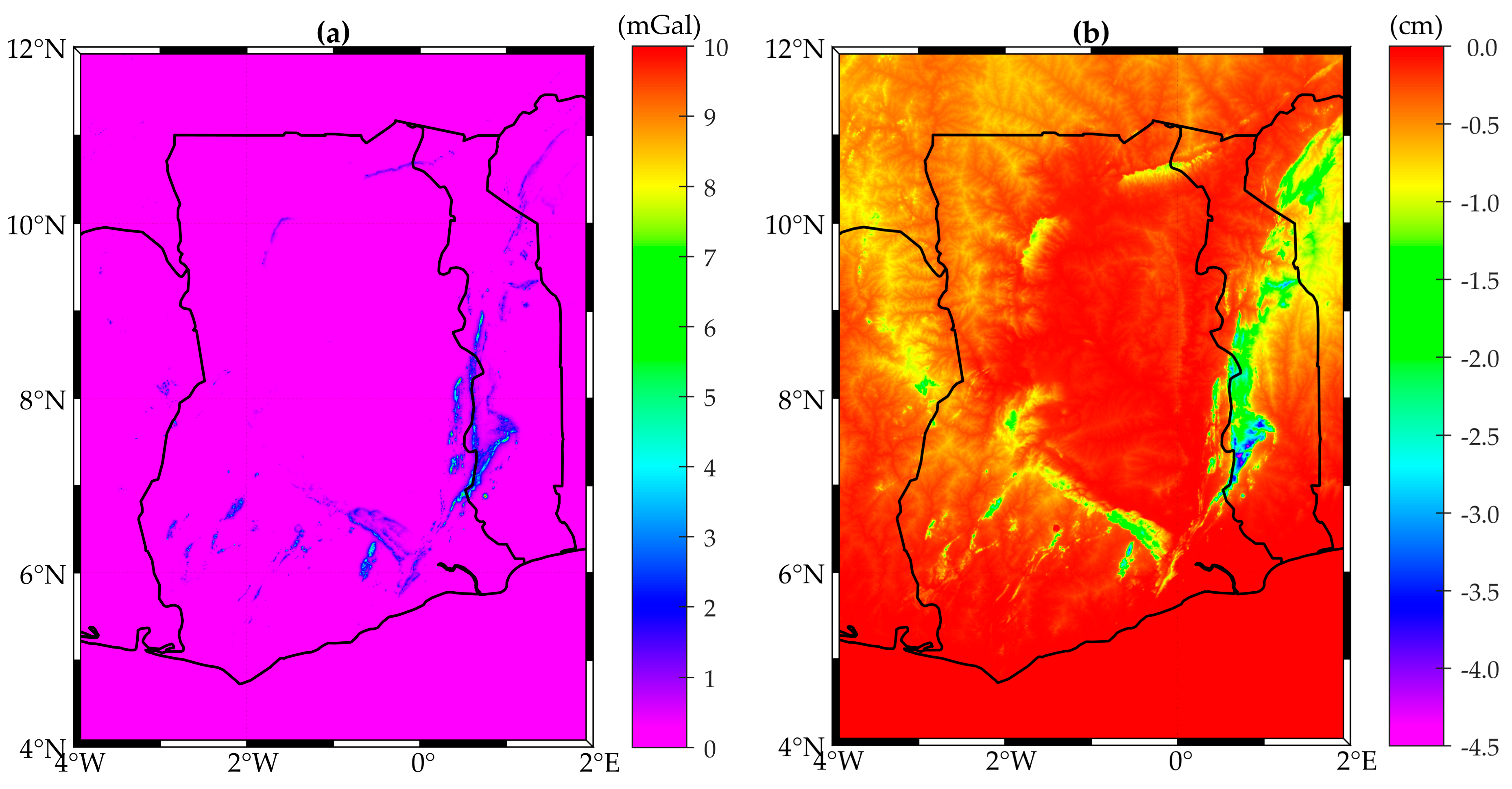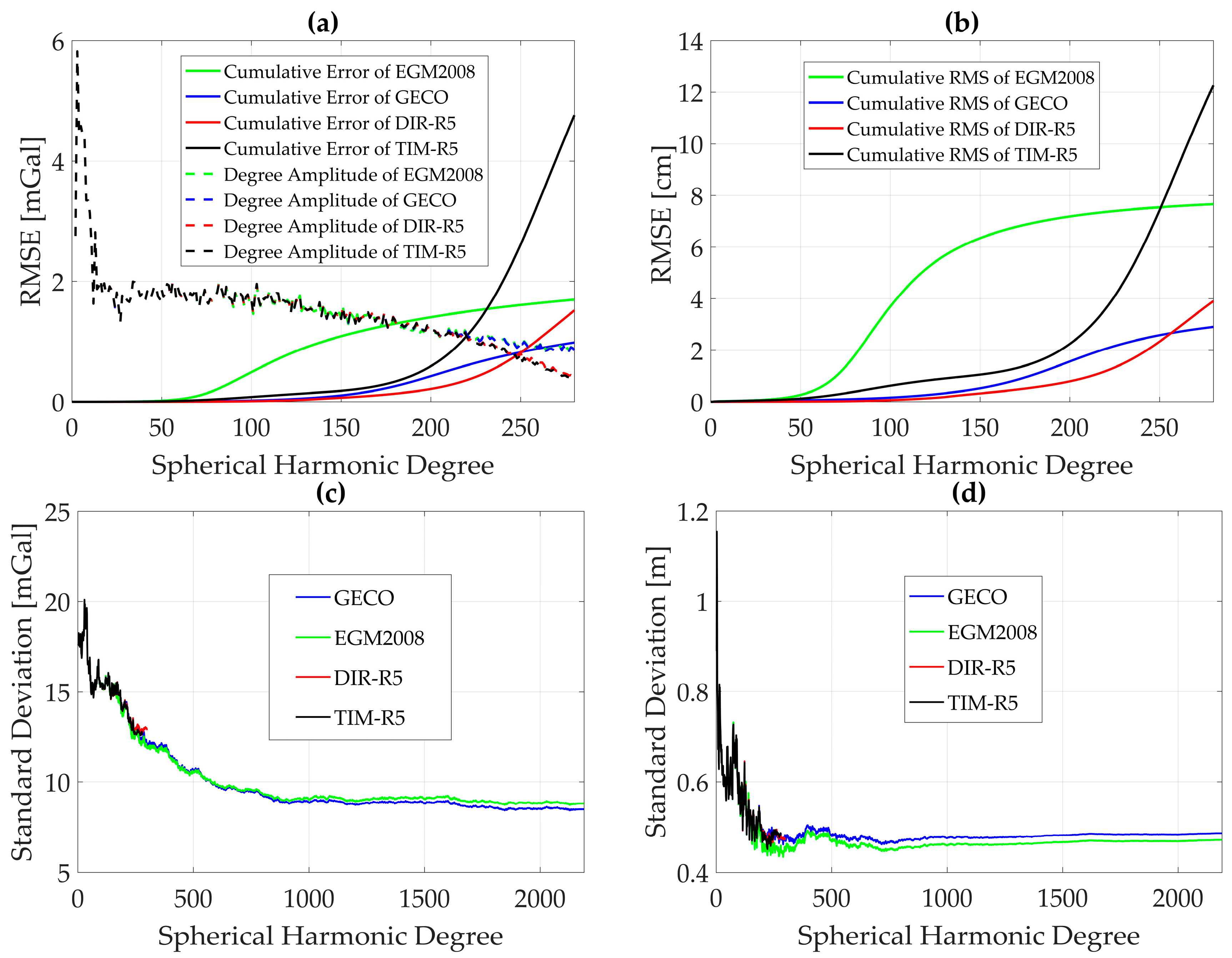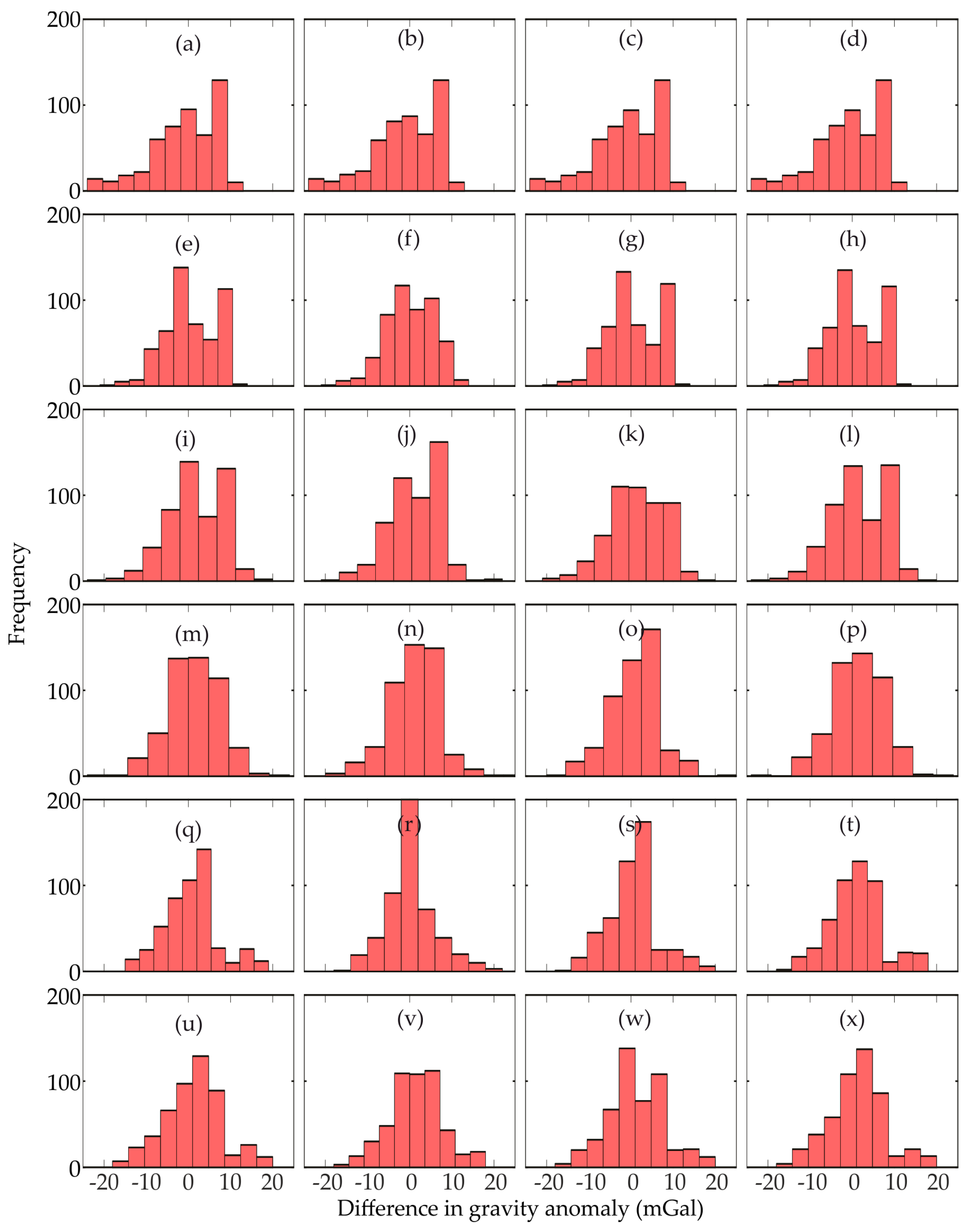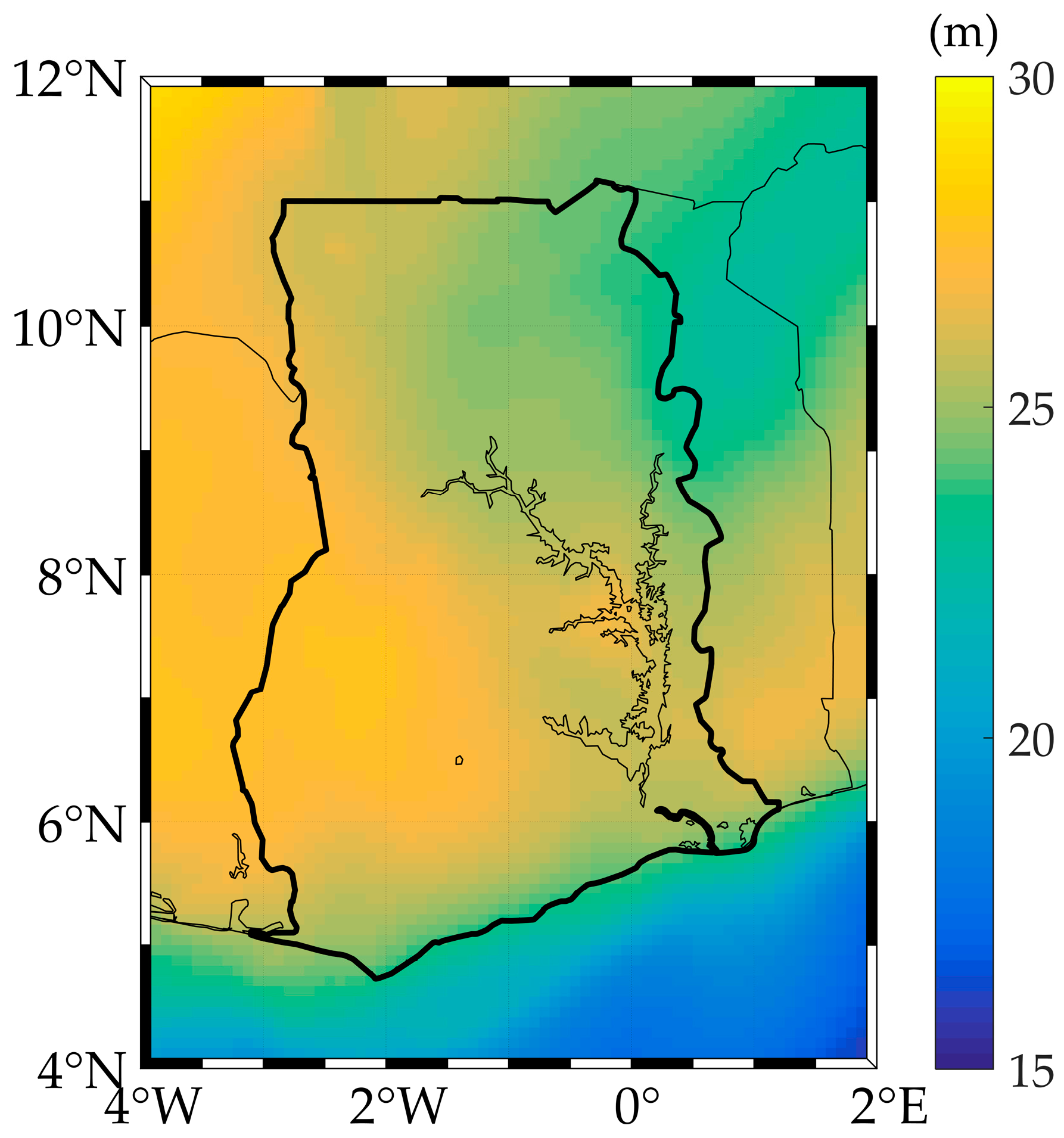Towards the Selection of an Optimal Global Geopotential Model for the Computation of the Long-Wavelength Contribution: A Case Study of Ghana
Abstract
:1. Introduction
2. Materials and Methods
2.1. Study Area and Terrestrial Data
2.2. Global Geopotential Models (GGMs) and Errors
2.3. The Gaussian Averaging Filter
2.4. Geoid Computation
3. Numerical Results and Discussion
4. Conclusions
Acknowledgments
Author Contributions
Conflicts of Interest
References
- Hofmann-Wellenhof, B.; Moritz, H. Physical Geodesy, 2nd ed.; Springer: Berlin, Germany, 2006; p. 413. [Google Scholar]
- Hirt, C.; Featherstone, W.E.; Marti, U. Combining EGM2008 and SRTM/DTM2006.0 residual terrain model data to improve quasigeoid computations in mountainous areas devoid of gravity data. J. Geod. 2010, 84, 557–567. [Google Scholar] [CrossRef]
- Jekeli, C. Alternative Methods to Smooth the Earth’s Gravity Field; Technical Report 327; Ohio State University: Columbus, OH, USA, 1981; p. 54. [Google Scholar]
- Huang, J.; Véronneau, M.; Mainville, A. Assessment of systematic errors in the surface gravity anomalies over North America using the GRACE gravity model. Geophys. J. Int. 2008, 175, 46–54. [Google Scholar] [CrossRef]
- Bomfim, E.P.; Braitenberg, C.; Molina, E.C. Mutual evaluation of global gravity models (EGM2008 and GOCE) and terrestrial data in Amazon basin, Brazil. Geophys. J. Int. 2013, 195, 870–882. [Google Scholar] [CrossRef]
- Klu, A.M. Determination of a Geoid Model for Ghana Using the Stokes-Helmert Method. Master’s Thesis, University of New Brunswick, Saint John, NB, Canada, 2015. [Google Scholar]
- Davis, P. Gravity Survey of Ghana; State Publishing Corporation (Printing Division): Accra, Ghana, 1962; p. 250. [Google Scholar]
- Mäkinen, J.; Ihde, J. The permanent tide in height systems. In Observing Our Changing Earth; Sideris, M.G., Ed.; Springer: Berlin/Heidelberg, Germany, 2009; pp. 81–87. [Google Scholar]
- Ekman, M. Impacts of geodynamic phenomena on systems for height and gravity. Bull. Géodésique 1989, 63, 281–296. [Google Scholar] [CrossRef]
- Tenzer, R.; Vatrt, V.; Abdalla, A.; Dayoub, N. Assessment of the LVD offsets for the normal-orthometric heights and different permanent tide systems—A case study of New Zealand. Appl. Geomat. 2011, 3, 1–8. [Google Scholar] [CrossRef]
- Pail, R.; Bruinsma, S.; Migliaccio, F.; Förste, C.; Goiginger, H.; Schuh, W.-D.; Höck, E.; Reguzzoni, M.; Brockmann, J.M.; Abrikosov, O.; et al. First GOCE gravity field models derived by three different approaches. J. Geod. 2011, 85, 819–843. [Google Scholar] [CrossRef]
- Bruinsma, S.L.; Förste, C.; Abrikosov, O.; Marty, J.-C.; Rio, M.-H.; Mulet, S.; Bonvalot, S. The new ESA satellite-only gravity field model via the direct approach. Geophys. Res. Lett. 2013, 40, 3607–3612. [Google Scholar] [CrossRef]
- Pavlis, N.K.; Holmes, S.A.; Kenyon, S.C.; Factor, J.K. The development and evaluation of the Earth Gravitational Model 2008 (EGM2008). J. Geophys. Res. Solid Earth 2012, 117. [Google Scholar] [CrossRef]
- Ustun, A.; Abbak, R.A. On global and regional spectral evaluation of global geopotential models. J. Geophys. Eng. 2010, 7, 369–379. [Google Scholar] [CrossRef]
- Gilardoni, M.; Reguzzoni, M.; Sampietro, D. GECO: A global gravity model by locally combining GOCE data and EGM2008. Stud. Geophys. Geod. 2016, 60, 228–247. [Google Scholar] [CrossRef]
- Wahr, J.; Molenaar, M.; Bryan, F. Time variability of the earth’s gravity field: Hydrological and oceanic effects and their possible detection using GRACE. J. Geophys. Res. Solid Earth 1998, 103, 30205–30229. [Google Scholar] [CrossRef]
- Torge, W.; Müller, J. Geodesy, 4th ed.; Walter de Gruyter: Berlin, Germany, 2012; p. 445. [Google Scholar]
- Ferreira, V.G.; Zhang, Y.; de Freitas, S.R.C. Validation of GOCE gravity field models using GPS-leveling data and EGM08: A case study in Brazil. J. Geod. Sci. 2013, 3, 209–218. [Google Scholar] [CrossRef]
- Featherstone, W.E. Software for computing five existing types of deterministically modified integration kernel for gravimetric geoid determination. Comput. Geosci. 2003, 29, 183–193. [Google Scholar] [CrossRef]
- Wichiencharoen, C. The Indirect Effects on the Computation of Geoid Undulations; The Ohio State University: Columbus, OH, USA, 1982; Volume 336, p. 104. [Google Scholar]
- Becker, J.J.; Sandwell, D.T.; Smith, W.H.F.; Braud, J.; Binder, B.; Depner, J.; Fabre, D.; Factor, J.; Ingalls, S.; Kim, S.-H.; et al. Global bathymetry and elevation data at 30 arc seconds resolution: SRTM30_plus. Mar. Geod. 2009, 32, 355–371. [Google Scholar] [CrossRef]
- Ferreira, V.G.; de Freitas, S.R.C.; Heck, B. Analysis of the discrepancies between the Brazilian vertical reference frame and GOCE-based geopotential model. In International Association of Geodesy Symposia; International Association of Geodesy: Munich, Germany, 2016; Volume 12, pp. 227–232. [Google Scholar]




| Model | Degree and Order | |||||
|---|---|---|---|---|---|---|
| 90 | 150 | 200 | 222 | 234 | 250 | |
| DIR-R5 | 7.907 | 5.832 | 6.430 | 5.975 | 6.408 | 6.952 |
| EGM2008 | 7.890 | 5.821 | 5.870 | 5.590 | 5.751 | 6.332 |
| GECO | 7.903 | 5.867 | 6.325 | 5.902 | 6.004 | 6.706 |
| TIM-R5 | 7.903 | 5.838 | 6.418 | 5.928 | 6.285 | 6.671 |
| Statistics | Degree and Order | Models | |||||
|---|---|---|---|---|---|---|---|
| 90 | 150 | 200 | 222 | 234 | 250 | ||
| Min | −1.321 | −1.246 | −1.248 | −1.216 | −1.198 | −1.245 | DIR |
| Max | 0.454 | 0.532 | 0.460 | 0.408 | 0.403 | 0.389 | |
| Mean | −0.344 | −0.373 | −0.402 | −0.430 | −0.436 | −0.449 | |
| STD | 0.534 | 0.487 | 0.471 | 0.468 | 0.468 | 0.483 | |
| SEM | 0.161 | 0.147 | 0.142 | 0.141 | 0.141 | 0.146 | |
| Min | −1.329 | −1.219 | −1.192 | −1.155 | −1.160 | −1.211 | EGM2008 |
| Max | 0.452 | 0.537 | 0.486 | 0.445 | 0.474 | 0.479 | |
| Mean | −0.348 | −0.371 | −0.382 | −0.403 | −0.390 | −0.410 | |
| STD | 0.534 | 0.482 | 0.460 | 0.457 | 0.460 | 0.464 | |
| SEM | 0.161 | 0.145 | 0.139 | 0.138 | 0.139 | 0.140 | |
| Min | −1.323 | −1.243 | −1.247 | −1.223 | −1.229 | −1.236 | GECO |
| Max | 0.454 | 0.530 | 0.463 | 0.410 | 0.441 | 0.438 | |
| Mean | −0.345 | −0.374 | −0.399 | −0.425 | −0.415 | −0.436 | |
| STD | 0.534 | 0.487 | 0.471 | 0.471 | 0.478 | 0.483 | |
| SEM | 0.161 | 0.147 | 0.142 | 0.142 | 0.144 | 0.146 | |
| Min | −1.322 | −1.242 | −1.241 | −1.206 | −1.206 | −1.251 | TIM |
| Max | 0.455 | 0.531 | 0.463 | 0.406 | 0.412 | 0.421 | |
| Mean | −0.344 | −0.372 | −0.401 | −0.429 | −0.433 | −0.439 | |
| STD | 0.534 | 0.487 | 0.470 | 0.466 | 0.469 | 0.486 | |
| SEM | 0.161 | 0.147 | 0.142 | 0.141 | 0.141 | 0.147 | |
| Statistics | Degree and Order | Models | |||||
|---|---|---|---|---|---|---|---|
| 90 | 150 | 200 | 222 | 234 | 250 | ||
| Min | 0.104 | 0.031 | 0.056 | 0.256 | 0.030 | 0.018 | DIR |
| Max | 41.092 | 39.772 | 39.369 | 39.711 | 40.212 | 39.980 | |
| Mean | 7.623 | 7.126 | 6.930 | 6.979 | 6.972 | 7.133 | |
| STD | 8.342 | 8.365 | 8.515 | 8.379 | 8.537 | 8.639 | |
| Min | 0.082 | 0.014 | 0.057 | 0.004 | 0.016 | 0.065 | EGM2008 |
| Max | 41.107 | 39.675 | 38.845 | 38.474 | 38.674 | 39.371 | |
| Mean | 7.620 | 7.075 | 6.807 | 6.842 | 6.824 | 6.858 | |
| STD | 8.347 | 8.352 | 8.470 | 8.341 | 8.442 | 8.745 | |
| Min | 0.102 | 0.062 | 0.030 | 0.245 | 0.008 | 0.042 | GECO |
| Max | 41.093 | 39.778 | 39.279 | 39.358 | 39.587 | 40.193 | |
| Mean | 7.622 | 7.122 | 6.930 | 7.013 | 7.056 | 7.158 | |
| STD | 8.342 | 8.364 | 8.514 | 8.353 | 8.488 | 8.735 | |
| Min | 0.101 | 0.058 | 0.036 | 0.255 | 0.118 | 0.042 | TIM |
| Max | 41.090 | 39.791 | 39.243 | 39.731 | 40.086 | 39.779 | |
| Mean | 7.623 | 7.123 | 6.922 | 6.947 | 6.974 | 7.117 | |
| STD | 8.343 | 8.362 | 8.507 | 8.375 | 8.526 | 8.639 | |
© 2017 by the authors. Licensee MDPI, Basel, Switzerland. This article is an open access article distributed under the terms and conditions of the Creative Commons Attribution (CC BY) license (http://creativecommons.org/licenses/by/4.0/).
Share and Cite
Yakubu, C.I.; Ferreira, V.G.; Asante, C.Y. Towards the Selection of an Optimal Global Geopotential Model for the Computation of the Long-Wavelength Contribution: A Case Study of Ghana. Geosciences 2017, 7, 113. https://doi.org/10.3390/geosciences7040113
Yakubu CI, Ferreira VG, Asante CY. Towards the Selection of an Optimal Global Geopotential Model for the Computation of the Long-Wavelength Contribution: A Case Study of Ghana. Geosciences. 2017; 7(4):113. https://doi.org/10.3390/geosciences7040113
Chicago/Turabian StyleYakubu, Caleb Iddissah, Vagner Gonçalves Ferreira, and Cosmas Yaw Asante. 2017. "Towards the Selection of an Optimal Global Geopotential Model for the Computation of the Long-Wavelength Contribution: A Case Study of Ghana" Geosciences 7, no. 4: 113. https://doi.org/10.3390/geosciences7040113
APA StyleYakubu, C. I., Ferreira, V. G., & Asante, C. Y. (2017). Towards the Selection of an Optimal Global Geopotential Model for the Computation of the Long-Wavelength Contribution: A Case Study of Ghana. Geosciences, 7(4), 113. https://doi.org/10.3390/geosciences7040113






